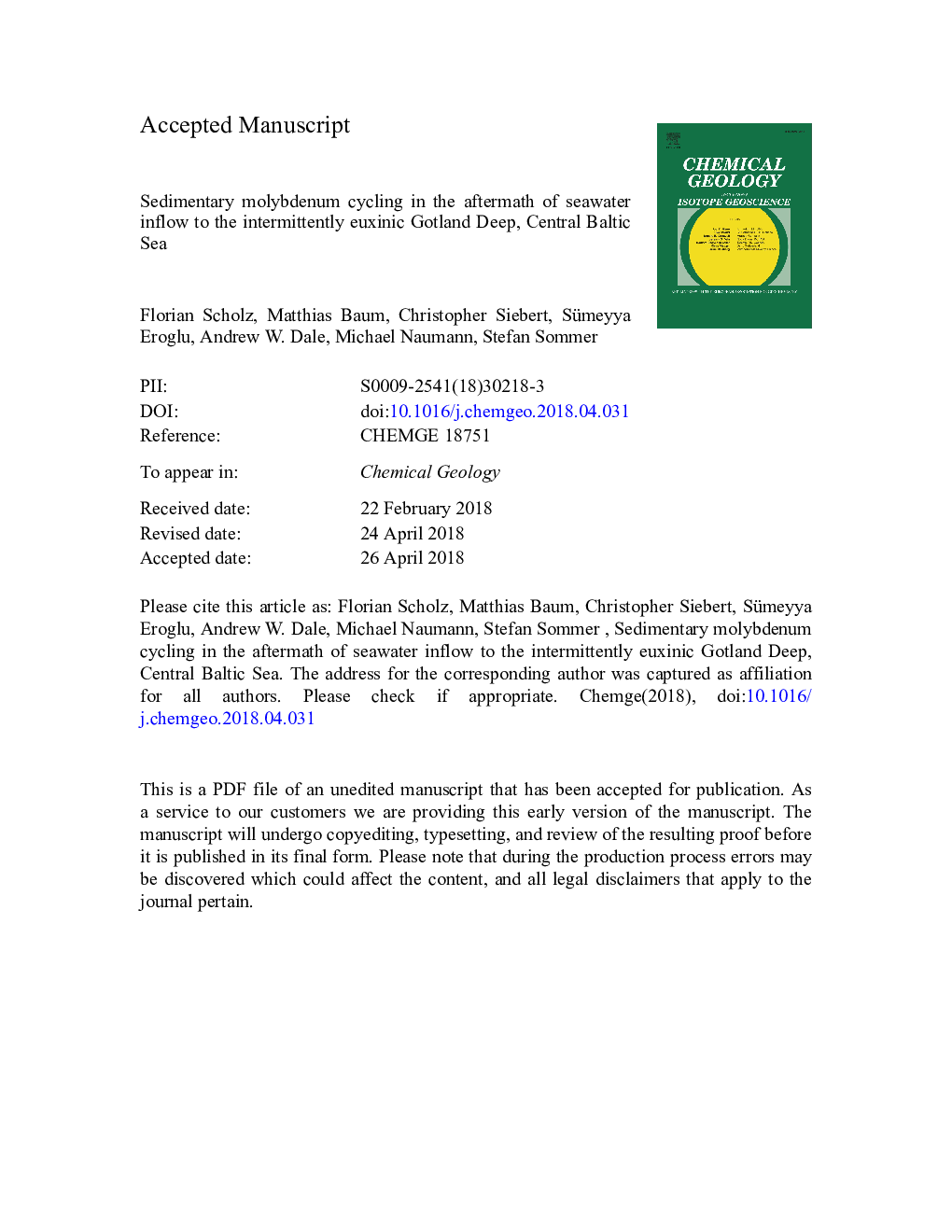| کد مقاله | کد نشریه | سال انتشار | مقاله انگلیسی | نسخه تمام متن |
|---|---|---|---|---|
| 8910185 | 1637483 | 2018 | 37 صفحه PDF | دانلود رایگان |
عنوان انگلیسی مقاله ISI
Sedimentary molybdenum cycling in the aftermath of seawater inflow to the intermittently euxinic Gotland Deep, Central Baltic Sea
ترجمه فارسی عنوان
مولیبدن سدیم دوچرخه سواری در نتیجه پس از ورود دریایی به گاه گاه به گاه گسسته، دریای مرکزی بالتیک
دانلود مقاله + سفارش ترجمه
دانلود مقاله ISI انگلیسی
رایگان برای ایرانیان
کلمات کلیدی
ایزوتوپهای مولیبدن، منگنز، دیانژن اولیه، دریای بالتیک، پالئوس-ردوکس،
موضوعات مرتبط
مهندسی و علوم پایه
علوم زمین و سیارات
ژئوشیمی و پترولوژی
چکیده انگلیسی
Molybdenum (Mo) concentrations and isotope compositions in sediments and shales are commonly used as proxies for anoxic and sulfidic (i.e., euxinic) conditions in the water column of paleo-marine systems. A basic assumption underlying this practice is that the proxy signal extracted from the geological record is controlled by long-term (order of decades to millennia) Mo scavenging in the euxinic water column rather than Mo deposition during brief episodes or events (order of weeks to months). To test whether this assumption is viable we studied the biogeochemical cycling of Mo and its isotopes in sediments of the intermittently euxinic Gotland Deep in the central Baltic Sea. Here, multiannual to decadal periods of euxinia are occasionally interrupted by inflow events during which wellâoxygenated water from the North Sea penetrates into the basin. During these events manganese (Mn) (oxyhydr)oxide minerals are precipitated in the water column, which are known to scavenge Mo. We present sediment and pore water Mo and Mo isotope data for sediment cores which were taken before and after a series of inflow events between 2014 and 2016. After seawater inflow, pore water Mo concentrations in anoxic surface sediments exceed the salinity-normalized concentration by more than two orders of magnitude and coincide with transient peaks of dissolved Mn. A fraction of the Mo liberated into the pore water is transported by diffusion in a downward direction and sequestered by organic matter within the sulfidic zone of the sediment. Diffusive flux calculations as well as a mass balance that is based on the sedimentary Mo isotope composition suggest that about equal proportions of the Mo accumulating in the basin are delivered by Mn (oxyhydr)oxide minerals during inflow events and Mo scavenging with hydrogen sulfide during euxinic periods. Since the anoxic surface sediment where Mo is released from Mn (oxyhydr)oxides are separated by several centimeters from the deeper sulfidic layers where Mo is removed, the solid phase record of Mo concentration and isotope composition would be misinterpreted if steady state Mo accumulation was assumed. Based on our observations in the Gotland Deep, we argue that short-term redox fluctuations need to be considered when interpreting Mo-based paleo-records.
ناشر
Database: Elsevier - ScienceDirect (ساینس دایرکت)
Journal: Chemical Geology - Volume 491, 5 July 2018, Pages 27-38
Journal: Chemical Geology - Volume 491, 5 July 2018, Pages 27-38
نویسندگان
Florian Scholz, Matthias Baum, Christopher Siebert, Sümeyya Eroglu, Andrew W. Dale, Michael Naumann, Stefan Sommer,
